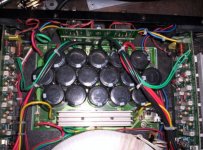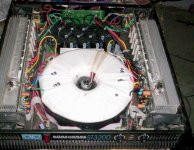part 2
Supply Switch at Vs*sqrt(2)/2
the theoretical efficiency is now at 85.9 %
with sine wave
direct link at image.
http://img61.imageshack.us/img61/848/efficenza2az2.gif
bye 🙂
Supply Switch at Vs*sqrt(2)/2
the theoretical efficiency is now at 85.9 %

with sine wave
An externally hosted image should be here but it was not working when we last tested it.
direct link at image.
http://img61.imageshack.us/img61/848/efficenza2az2.gif
bye 🙂
Where the switch occurs at must be related to the program material. What is best for sine wave is not always the best for music. Technics did temperature tests with actual program material to determine what was best for home theater.
Bob Carver also did similar tests for three tiers.
Bob Carver also did similar tests for three tiers.
Hi Gold,
Djk is right the actual efficiency with Musical waveform is much different as I already said, with pure sinewave its very much different thing, because the Musical Content features lots of High amplitude peaks in comparision with normal average program material and this is where the Class-H/G amp seeks its advantage and proving more efficiency....
Thanks DJK for valuable comments....
K a n w a r
Djk is right the actual efficiency with Musical waveform is much different as I already said, with pure sinewave its very much different thing, because the Musical Content features lots of High amplitude peaks in comparision with normal average program material and this is where the Class-H/G amp seeks its advantage and proving more efficiency....
Thanks DJK for valuable comments....
K a n w a r
Hey Gold_XYZ, here is an image of a spreadsheet we created up at my work. I will only share a screen shot for obvious reasons. All the formulas can be easily derived as you are already doing but what is interesting is to see how efficiency changes with different settings. Basically, the sheet is set up to where you enter in a power level (top box) and then enter in thresholds for the minimum fixed DC rail, where it changes mode and how much headroom the rails maintain above the output signal. We found the sheet to be pretty accurate with bench work. The screen shot I have shows a 60W amplifier with a minimum rail of 10V (assuming split supply in all calculations) and the rail is kept at 2V above the output signal. The efficiency is 89% with these parameters. Very interesting to plot power dissipation vs. output power with different levels for all the parameters and compare the shape of the curves with each other and the classical bell shaped curve for a AB amp.
-SL
-SL
Attachments
Hi 😀
i have made some errors...
in part 1 the integration is in "d wt" not in "d t"
in part 2 Vsb is without terms "sin(wt)"

i have made some errors...

in part 1 the integration is in "d wt" not in "d t"
in part 2 Vsb is without terms "sin(wt)"

a little correction 🙄
Part1 :
http://img216.imageshack.us/img216/579/efficenza1zf4.gif
Part2 :
http://img214.imageshack.us/img214/598/efficenza2gp9.gif
New part 3 :
!! the part 3 are incomplete and I still owe it to verify. !!
http://img145.imageshack.us/img145/3325/efficenza3le4.gif
The maximum efficiency seems to be when the supply switch
at sqrt(2)/2 (for a sine wave).
bye
Part1 :
http://img216.imageshack.us/img216/579/efficenza1zf4.gif
Part2 :
http://img214.imageshack.us/img214/598/efficenza2gp9.gif
New part 3 :
!! the part 3 are incomplete and I still owe it to verify. !!
http://img145.imageshack.us/img145/3325/efficenza3le4.gif
The maximum efficiency seems to be when the supply switch
at sqrt(2)/2 (for a sine wave).
bye

the part 3 🙂
direct link : http://img215.imageshack.us/img215/1358/efficenza3qp6.gif
direct link : http://img95.imageshack.us/img95/8342/effgrafgs5.jpg
The max efficiency is when (with a sine wave) the rail switch
at Vs*sqrt(2)/2. 85.9 % (class H) vs 78.5% (class AB)
An externally hosted image should be here but it was not working when we last tested it.
direct link : http://img215.imageshack.us/img215/1358/efficenza3qp6.gif
An externally hosted image should be here but it was not working when we last tested it.
direct link : http://img95.imageshack.us/img95/8342/effgrafgs5.jpg
The max efficiency is when (with a sine wave) the rail switch
at Vs*sqrt(2)/2. 85.9 % (class H) vs 78.5% (class AB)
ThankYou Kanwar 
And besides I apologize me to perhaps have posted mathematical matters too much boring or heavy
bye


And besides I apologize me to perhaps have posted mathematical matters too much boring or heavy

bye


Hi Carlos,
Not much powerful only just 2 X 1600W RMS per channel at 2 ohms
just a simple Class-H prototype
but will get into production in couple of days......
regards,
K a n w a r
Not much powerful only just 2 X 1600W RMS per channel at 2 ohms
just a simple Class-H prototype
but will get into production in couple of days......
regards,
K a n w a r
Hi K a n w a r
Compliments for Your new creation !
with 1.6KW I now understand the necessity of the class H..
Bye 😀
P.S. For the testing he can be very useful the Series 2700 of AP
(I have used for many years the old system one without problems)
http://ap.com/index.php

Compliments for Your new creation !

with 1.6KW I now understand the necessity of the class H..

Bye 😀
P.S. For the testing he can be very useful the Series 2700 of AP
(I have used for many years the old system one without problems)
http://ap.com/index.php

Very Very nice amp Kanwar! 😉
What VA rating is the Transformer?
Its finally very good to see one of your creations....
What VA rating is the Transformer?
Its finally very good to see one of your creations....
- Home
- Amplifiers
- Solid State
- The Class - H Amplifier








